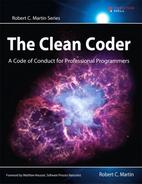Book Description
Robert C. Martin reveals the disciplines, techniques, tools, and practices that separate software craftsmen from mere "9-to-5" programmers
One of the world's most respected programmers takes software craftsmanship to the next level, answering hard questions about what it really means to be a craftsman
Useful advice on how to code, refactor, test, estimate, manage time, and learn
By the legendary "Uncle Bob," who helped launch the Agile movement and wrote Software Development's influential "Craftsmanship" column
Programming languages and development platforms burst into fashion, and then fade away. Software paradigms briefly dominate, then shift. Methodologies are debated religiously, agreed upon - and soon scrapped altogether. It's no wonder that application development has a high rate of turnover and burnout. Programmers who endure and succeed amidst swirling uncertainty have one thing in common: they all care deeply about the practice of creating software. They treat it as a craft. In this much-anticipated new book, software legend Robert C. Martin explains why programmers should care about their jobs, how organizations can foster the type of environment that allows programmers to succeed, and what it means for individual software developers to truly work as craftsmen. The Clean Coder goes beyond "values and attitudes" to fully document the specific disciplines, techniques, tools, and practices that successful software craftsmen share in common. Throughout his 40-year career at the forefront of movements ranging from agile and extreme programming to object-oriented development, "Uncle Bob" has consistently been a voice of practical common sense and enduring wisdom. He has now written a book that every aspiring and ascending software craftsman can use: to write better software, and to gain greater personal fulfillment in doing so.
Table of Contents
- Title Page
- Copyright Page
- Contents
- Praise for The Clean Coder
- Foreword
- Preface
- Acknowledgments
- About the Author
- On the Cover
- Pre-Requisite Introduction
- 1. Professionalism
- 2. Saying No
- 3. Saying Yes
- 4. Coding
- 5. Test Driven Development
- 6. Practicing
- 7. Acceptance Testing
- 8. Testing Strategies
- 9. Time Management
- 10. Estimation
- 11. Pressure
- 12. Collaboration
- 13. Teams and Projects
- 14. Mentoring, Apprenticeship, and Craftsmanship
- A. Tooling
- Index
- Footnotes
